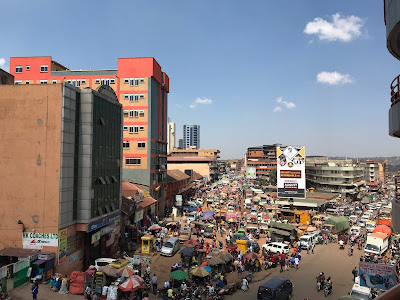 |
| A view of Arua Park in down town Kampala. Photo Credit: Mary Ongwen |
I had missed Uganda and its capital. I wanted to
experience the downtown markets of Nakasero and kikuubo, roll with the cool guys on SafeBoda’s, sit
with the local women as they lit sigiris’ and
fanned firewood. I wanted to dine in Kampala Serena, sip cappuccinos and lattes
at Cafesseria. I wanted to travel to the countryside, see all things, do all
things, taste, relish, embrace. I wanted to nourish a hunger that had grown
over three years. See my papa and mama and siblings.
Familiar tastes, sights, sounds and people allowed for a
deep-seated comfort – a return to a warm nook, a favorite place. The warm hugs,
the worn paths, the happy stories, the heartaches connecting lives at the
origin of life’s pulse. People finished sentences like I was never gone.
Virtual friendships were sealed, the connections encompassed faith, beliefs,
and life values.
After a while the cracks in the ceiling surfaced, I was reminded of the
annoying humps on Ntinda stretcher. The touts who claimed the taxi was
about to leave only to yo-yo in the same spot for another ten minutes. I began
to dodge potholes from memory and understand the non-verbal communication of
the security guards. I remembered personal space didn’t have a place here.
I was back.
I was on the road a lot so most impressions were influenced by journeys
and interactions within the city.
Beyond the discomfort of dust caked in layers on my eyelashes and throat,
Kampala’s growth is evident. More of everything – economic growth, private
ventures, indiscipline, creativity, insecurity, wealth, agriculture and more.
Kampala’s intensity numbed and exhilarated all at once.
Urban migration is real. Youth employment is of grave importance. What were
once outskirts -Mukono, Najjeera, Kulambiro are now in-skirts and they continue to
grow. Growth is good, the disorganization not so much. KCCA has its work cut
out.
Kampala is an urgent city – like a continuous party or a scene in a Grand
Theft Auto game: a boda accident over here, a fender bender over there. Taxi
touts call for passengers, boda cyclists whizz by and assume a ride contract
because of eye contact. Music blares from supermarket speakers, road side
vendors loom over car windows in traffic. The car hoots and street side
conversations – everybody minds their own business and others.
A huge truck knocks down the wall to a private residence.
The back of the truck remains logged between the compound and the road. The
truck hangs in midair over a drainage – hard to demystify the “cool” maneuver
that resulted in this situation. Traffic slogs up the Kiwatule turn off, idlers surround – each with a version of how the
accident unfolded, life resumes.
The incessant traffic jams (except at 2:00am perhaps), taxi drivers with
their own set of road rules and the boda-boda cyclists that skillfully made
sudden appearances at blind spots were most unnerving. Good to have more
traffic lights, and the bypasses that help ease traffic on the outskirts –
except everyone is thinking the same thing.
Ugandan’s remain trendy. After one or two meetings with a friend who
politely told me to smarten up, I begun to scan the fitted skirts, the high
heels and matte lipstick painted in cafés, offices and on Kampala road. It was
important to represent and not shame the diaspora. Ugandans have class.
Ugandan’s are still friendly but a little more aggressive. They still help
with directions and empathize with those in need. Drivers cut into traffic
mercilessly, everyone assumes right of way. After two instances of courtesy on
the road one easily joins the road rage because you soon become the enemy for
giving way, choice words are thrown through windows. Once immersed in the
aggressive zone, one chances on a driver who’s gracious, allows you to join the
road or make a turn and suddenly the trance wears off and you realize there are
some sane people out there.
The traffic police? I will leave those alone – not enough time or space to
delve into the details.
Uganda suffers lopsided development, but development none the less.
There’s stack contrast in quality of infrastructure between eastern and western
Uganda. A clear line between the haves and have not’s. Again, not enough time
or space to delve into the details here.
Good food – Ugandans have not lost taste. The number of restaurants, Cafés
and kafundas just go to show Ugandans like
their food and they like it steamy hot. From The Lawns, to Café Java’s and all
the fabulous eat outs in between the choices are endless from muchomo to muchuzi chips.
We will talk customer service another day.
Good music! Ugandan’s love to have a good time. I met a friend in Ntinda,
the location had no signage – those who know it, know it. Those who do not
probably don’t belong. The music was cool, the ambience just right! An
old tymers kind of thing. Highly recommended as a wind down zone after a day’s
hustle. One travels back in time to life’s good moments – you literally forget
the guy who nyigged you, the missed promotion that was
rightfully yours, the business deal that fell through. Yah!
A lot has changed and yet so much remains the same. I was glad to fit in
and yet study the country from a distance.
Subsequent articles will be short stories, interesting events and
encounters along the way.
Soon moving to WordPress: http://www.ugandanmama.wordpress.com.




No comments:
Post a Comment
Hey! Thanks for dropping by :-)